
Sometimes even good guns get lost in the shuffle, and this is the unfortunate saga of how it happened to the Steyr GB.
Every now and then, a pistol design comes around that should take the shooting world by storm. Sometimes these designs suffer from poor marketing, poor timing or are simply a little too “ahead of their time.” Many times, it’s all of the above. Such was the case with the Steyr GB, an Austrian-designed pistol that could’ve and should’ve made a lasting impression … but, unfortunately, it was consigned to the “also ran” gun rack of history.
This was a very accurate fixed barrel system that used a unique gas system involving a port slightly ahead of the chamber—and supported an 18-round magazine. It truly was the first of its kind with regard to the latter when it was unveiled in the 1980s, even if you ignore the engineering marvels that made this a work of art in the realm of pistolcraft.
How could such an interesting design have gotten lost in the shuffle? Its unique story is a tragedy, as some experts feel this could’ve been an influential and award-winning design if it hadn’t run into a slew of unfortunate events.

Steyr GB History
At the end of World War II, the Austrian military issued three basic handguns to its troops: the Browning Hi-Power, the Colt M1911 and the Walther P38. These handguns were in good supply and condition. And, despite popular opinion, an issued handgun isn’t exactly a high-priority piece of gear for combat troops.
Nonetheless, if there’s one thing any military seeks, it’s uniformity and conformity. By the 1960s, the search was on for a new pistol for the Austrian armed forces. Steyr-Daimler-Puch was the most famous small arms manufacturer in Austria, and they set their engineers to the task of developing a full-sized duty pistol in 9mm for the Austrian military.

Although a rather conventional-looking pistol, the GB was loaded with innovative features not found in any other handgun up to that point in time. It was a delayed-blowback operated, double-action pistol with a fixed barrel that utilized a Barnitzke system, which uses gas pressure from the fired cartridge and feeds it through a small port in the barrel in front of the chamber to slow down the rearward motion of the slide while firing. Additionally, it offered an 18-round double-stack magazine, polygonal rifling, reduced number of moving parts and no external safety … aside from a decocking lever.
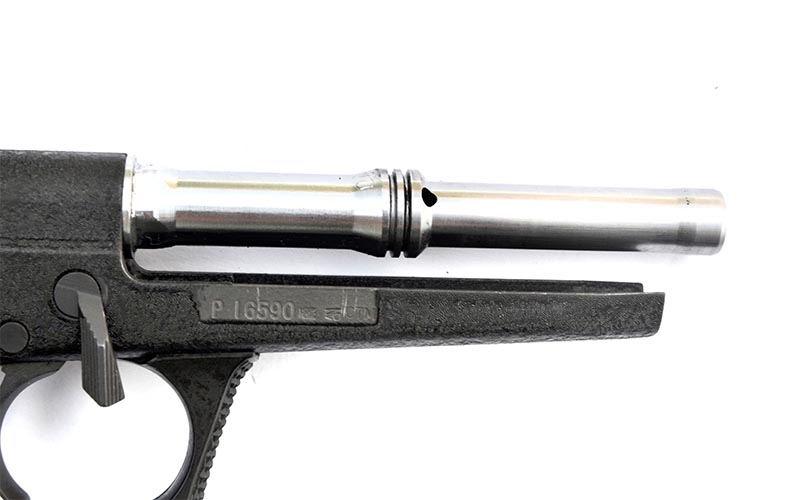
The GB was first fielded by the Austrian military in 1972, and it seemed to be very popular with troops who shot it. Unfortunately, Steyr and the Austrian military couldn’t come to terms in regard to a sale, so the pistol wasn’t adopted. Rather than release the pistol for commercial sales, Steyr decided to put it on ice for almost a decade.
Interestingly, the GB was referred to as the Pistole 18 Schuss—or Pi 18—during development, referring to its 18-round magazine capacity. Upon its commercial release in the 1980s, this was changed to GB from the term gas bremse, meaning “gas brake.”
Before we get to the 1980s and the Steyr GB, we need to look at what happened with regard to the Pi 18 in the mid to late 1970s.
Enter the Rogak
In 1974, one of Steyr’s U.S. distributors, Les Rogak, received a design document on Steyr’s Pi 18. The exact story differs depending upon who you talk to about it. Some claim a disgruntled engineer at Steyr sent a design based on a very early pistol. Some claim that Steyr sent them as a press release sort of arrangement in case the pistol were to go into production and then made commercially available.
Regardless of how he got the schematics, Rogak apparently took it upon himself to set up a factory to produce the Pi 18 under the slightly simpler name of the L.E.S. P18. As an added (yet dubious) bonus, these pistols would be constructed of stainless steel.
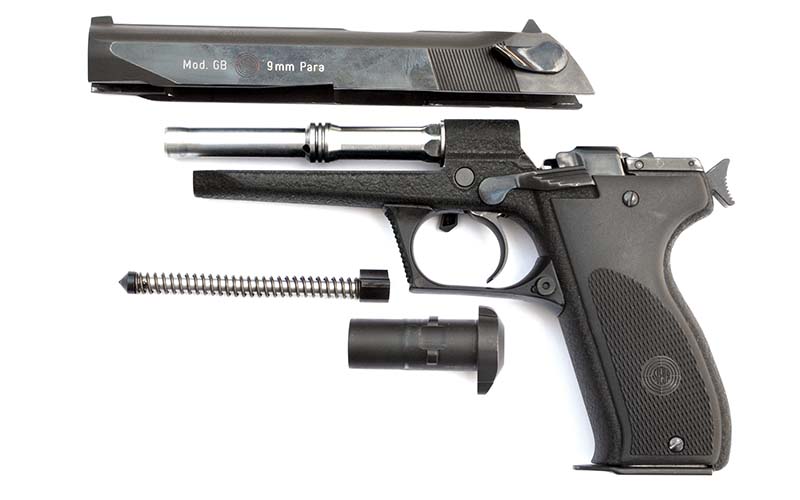
Unfortunately, the project was doomed from the start. For one thing, use of the Barnitake System requires especially close fittings and tolerances. Apparently, this was applied very hit-and-miss to the Rogak … so much so that many of these pistols have reliability issues, and the extractor has been known to rip the heads off the cases because of this.
One popular firearms magazine at the time referred to the Rogak as the “Original Jammamatic.” Other aesthetic shortcuts, such as the use of Philips head screws to secure the pistol’s grips, were pointed out.
When Steyr caught wind of this, they issued a cease-and-desist order followed by a lawsuit. The association was damaging to the Steyr brand, and a U.S. Military trial was approaching the horizon for a new pistol for the U.S. Armed Forces.
By the time the case made it to court in 1981, L.E.S. had shuttered its factory, and the Rogak P18 was a thing of the past—but not before between 1,000 and 1,500 pistols were made between 1975 and 1980.
Now The Steyr GB
Reeling from the Rogak debacle, Steyr made a few minor changes to the Pi 18, including adding a crinkle-type finish, similar to that used on Sterling sub-machineguns, to the frame and a high-luster blue to the flats of the slide.
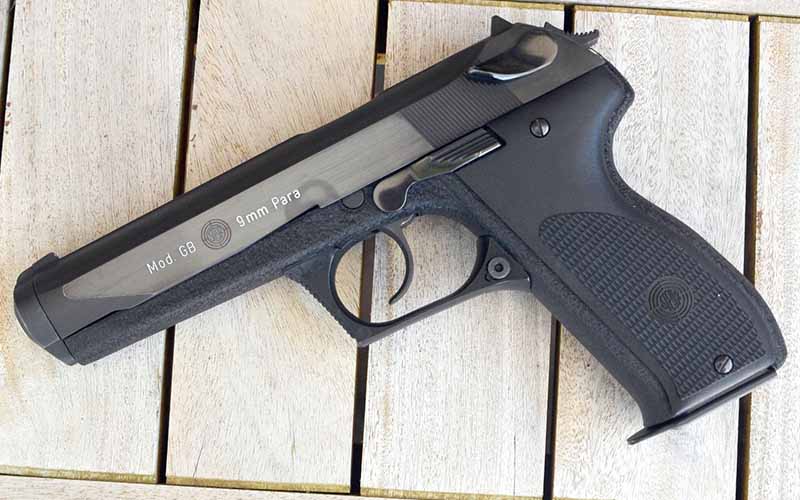
The pistol didn’t win the contract for the U.S. service pistol, that instead going to Beretta. It also failed to win any other European military handgun contracts. Most of those went to the even more radical “other Austrian handgun” from a then unknown Austrian shower curtain ring and bayonet manufacturer, Gaston Glock, who utilized a high-impact polymer frame that really did change the world of handguns.
A handful of international special forces and intelligence agencies bought small quantities of the Steyr GB, but nothing of any substantial quantity. Steyr discontinued the pistol in 1988 after manufacturing between 15,000 and 20,000 in total.
Shooting the Steyr GB
As a longtime fan and collector of everything Steyr, I happened upon a GB model in my local Cabela’s. It came with no box or manual, but it did include two 18-round magazines, and it was priced so low that even if I had no interest in Steyr’s firearms at all, it would’ve still been a steal.
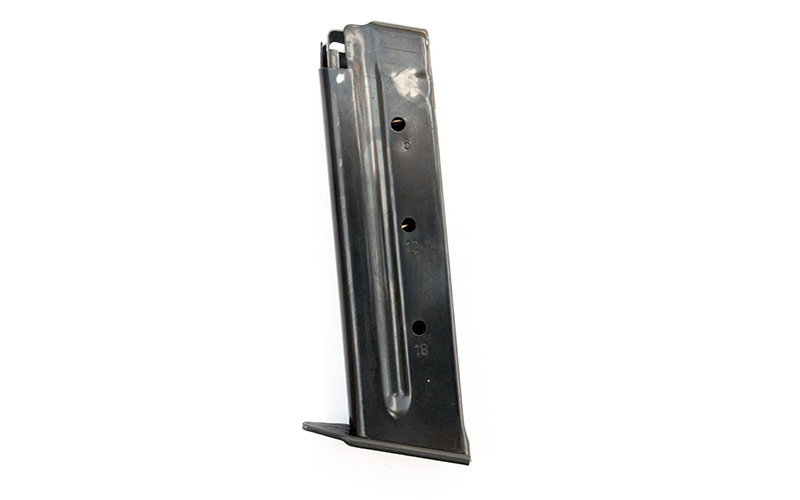
The reason for the low price of this pistol had a lot to do with it being confused with the L.E.S. P18. Old gun shop lore confused the two pistols after all the bad press the American knockoff had received. After all, who wants to buy an inaccurate and unreliable pistol?
We hit the range with a few boxes of Aguila 124-grain FMJ ammunition. Loading the 18-round magazines is mostly easy, but those last two rounds offer a bit of resistance. The trigger in single-action mode is about 2¾ pounds with a bit of take-up. Double-action is about 6 pounds.
Typical five-shot group size at 50 feet averages about 1.34 inches, with the smallest of these being 0.74 inch. Not counting custom 1911s, this was one of the more accurate semi-autos I’ve ever fired, ranking up there with the SIG P210 or the Heckler & Koch P7M8.
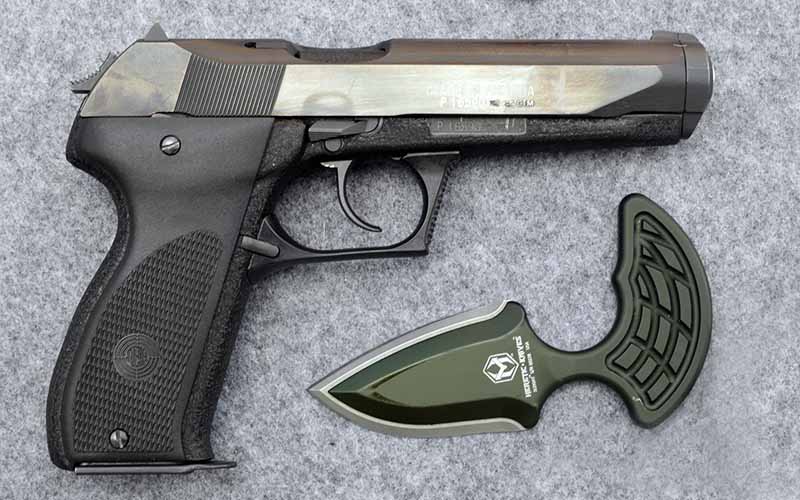
There were no failures to feed, fire, eject or extract of any kind. Between the fixed barrel, weight of an all-steel pistol and all black almost target-style sights, this is a pistol that can easily be shot all day long.
As with any pistol that has been out of production for more than 30 years—and wasn’t ever imported in great quantities—spare parts are extremely hard to come by. Even spare magazines will set you back close to $200 each, if not more.
There are very few holsters for this pistol unless you go the custom route. The Bianchi M12 military holster works well, but this is obviously not a good choice for concealed carry.

Final Thoughts
The Steyr GB represents a well-executed pistol design on many fronts, particularly considering the time period during which it was designed. It’s probably too heavy by today’s standards, but its accuracy and reliability can’t be denied. Pistols like this are a true gem if you can find one at a good price.
It might be nice to see Steyr resurrect the design, but that’s probably a tall order for a company that takes very little input from their end users or the American market in general. They still manufacture magazines with a profile suitable for holding 13 or 14 rounds of ammo, although blocked at 10 rounds, in spite of that draconian law expiring almost two decades ago.
Still, a slightly upgraded version with true target sights, or at least an optic-mounting plate, could be something to dream about.
This pistol went from an oddity that filled a void in a collection of Steyrs to quickly becoming a favorite range companion. If you happen upon one at a fair price and it has a few magazines, it’s not one to pass up as a collector … or a shooter.
Editor's Note: This article originally appeared in the October 2022 issue of Gun Digest the Magazine.
More Classic Military Guns:
- Why The Mauser C96 “Broomhandle” Still Looms Large
- The Makarov And Other 9x18mm Pistols
- Nagant Revolver: Unique Relic From Behind The Iron Curtain
- M1917 Enfield: The Unofficial U.S. Service Rifle
- Browning Automatic Rifle: The Gun That Changed the Infantry

Next Step: Get your FREE Printable Target Pack
Enhance your shooting precision with our 62 MOA Targets, perfect for rifles and handguns. Crafted in collaboration with Storm Tactical for accuracy and versatility.
Subscribe to the Gun Digest email newsletter and get your downloadable target pack sent straight to your inbox. Stay updated with the latest firearms info in the industry.

![Best Concealed Carry Guns In 2025 [Field Tested] Wilson Combat EDC X9S 1](https://gundigest.com/wp-content/uploads/Wilson-Combat-EDC-X9S-1-324x160.jpg)


![Best 9mm Carbine: Affordable PCCs [Tested] Ruger Carbine Shooting](https://gundigest.com/wp-content/uploads/Ruger-Carbine-Shooting-100x70.jpg)
![Best AR-15: Top Options Available Today [Field Tested] Harrington and Richardson PSA XM177E2 feature](https://gundigest.com/wp-content/uploads/Harrington-and-Richardson-PSA-XM177E2-feature-100x70.jpg)

I bought an L.E.S. Rogak in the ’70’s because I was smitten with the features – capacity, fixed barrel, gas-delayed, double action/single action – it seemed like a dream. Close. Closer? Nightmare. FIRST TIME I shot it, it disassembled in my hand. First shot. Let’s just say that Rogak was not a precision manufacturer. I never shot it again.
I still have it as a curiosity. Shoulda bought a Steyr. Probably worth way more than I paid for it, just as an oddity of pistol history. Moot now, as the high capacity afforded by 9mm cartridge shape has been rendered superfluous by idiotic magazine capacity limitations. On the other hand, the .40 S&W and .45 ACP are destined to come roaring back as a result. (I wonder how many .40 S&Ws would fit in a 1911 double-stack magazine? In a world not corrupted by Democrats, that is.)
I always wanted one of these back in the 1980’s. I liked the gas retarded systems like the GB and the P7 but as cool as the P7 seemed. The GB was my highest interest because of the Steyr company. I was always sorry that it didn’t make it in the market and I could never afford one.